2012年04月18日
Mark 47 Mod 0 Striker 40mm
私たちのブログを訪問していただきありがとうございます。あなたがお持ちの場合DIYの要求は私達に電子メールを送信してください。
New full-auto grenade launcher system with target acquisition and ranging technology!
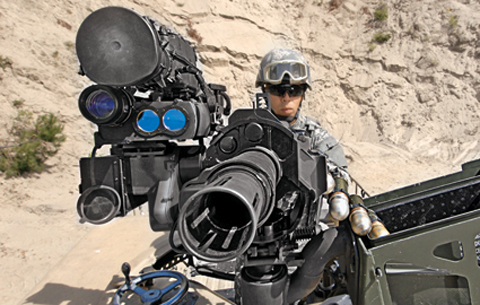
The Mk 47 Mod 0 40mm ALGL mates to a high-tech integrated target acquisition and ranging system as well as with HEAB ammo to become a new order of weapon that not only delivers first-round hits, but can deliver PP-HE/SD aerial burst rounds as well.
From the first rock or stick thrown, either at an adversary or at a creature that looked like food, the object of projectile or missile weapons has been to put destructive energy on the target. Until the advent of gunpowder, it was merely the weight and mass of the projectile transferring kinetic energy to the target. But as soon as it was discovered that an exploding projectile or missile could additionally carry chemical energy to the target, exploding missiles were used, followed by cannon with bursting projectiles. Of course both these methods are still used today.
Carrying kinetic energy to the target requires a projectile with both mass and velocity, which requires a strong and therefore heavy launch system, whose weight rises exponentially with the mass and velocity of the projectiles used. This reality has tended to limit kinetic energy rounds to small arms at one end of the scale or anti-armor artillery pieces at the other.
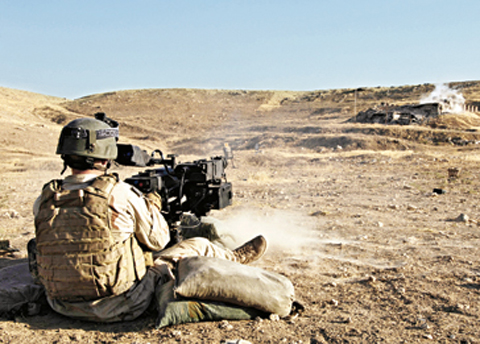
A SpecOps trooper gets familiar with the Striker 40mm as it was first deployed to the sandbox. The integrated target acquisition technology delivers the rounds just behind what would ordinarily provide cover.
The advantage of the larger shell is that it can carry a lot of chemical (explosive) energy in addition to its kinetic energy. What has always been needed is a system for Infantry that would deliver usable chemical energy at infantry ranges. First came hand-thrown grenades (the name coming from the pomegranate, which the early ones resembled); then came rifle adapters to throw specialized grenades farther and more accurately. Finally in the late 1950s were fielded dedicated grenade launchers in the form of the M79 “Bloop” gun that fired a self-contained cartridge with explosive projectile. This idea worked so well, it was soon followed by various crew-served belt-fed versions with similar projectiles, such as the preeminent Mk 19, which has been copied, licensed and imitated with varying degrees of success.
By F.W. Demara
BLOG ARCHIVES

New full-auto grenade launcher system with target acquisition and ranging technology!

The Mk 47 Mod 0 40mm ALGL mates to a high-tech integrated target acquisition and ranging system as well as with HEAB ammo to become a new order of weapon that not only delivers first-round hits, but can deliver PP-HE/SD aerial burst rounds as well.
From the first rock or stick thrown, either at an adversary or at a creature that looked like food, the object of projectile or missile weapons has been to put destructive energy on the target. Until the advent of gunpowder, it was merely the weight and mass of the projectile transferring kinetic energy to the target. But as soon as it was discovered that an exploding projectile or missile could additionally carry chemical energy to the target, exploding missiles were used, followed by cannon with bursting projectiles. Of course both these methods are still used today.
Carrying kinetic energy to the target requires a projectile with both mass and velocity, which requires a strong and therefore heavy launch system, whose weight rises exponentially with the mass and velocity of the projectiles used. This reality has tended to limit kinetic energy rounds to small arms at one end of the scale or anti-armor artillery pieces at the other.

A SpecOps trooper gets familiar with the Striker 40mm as it was first deployed to the sandbox. The integrated target acquisition technology delivers the rounds just behind what would ordinarily provide cover.
The advantage of the larger shell is that it can carry a lot of chemical (explosive) energy in addition to its kinetic energy. What has always been needed is a system for Infantry that would deliver usable chemical energy at infantry ranges. First came hand-thrown grenades (the name coming from the pomegranate, which the early ones resembled); then came rifle adapters to throw specialized grenades farther and more accurately. Finally in the late 1950s were fielded dedicated grenade launchers in the form of the M79 “Bloop” gun that fired a self-contained cartridge with explosive projectile. This idea worked so well, it was soon followed by various crew-served belt-fed versions with similar projectiles, such as the preeminent Mk 19, which has been copied, licensed and imitated with varying degrees of success.
By F.W. Demara
BLOG ARCHIVES

2012年04月18日
B&T APC9 Civilian Model
私たちのブログを訪問していただきありがとうございます。あなたがお持ちの場合DIYの要求は私達に電子メールを送信してください。
Brügger & Thomet is now selling in Europe a semi-automatic civilian-legal version of the 9mm B&T APC9 submachine gun which they unveiled last year. A TFB reader in the Czech Republic took these great photos of the new gun…
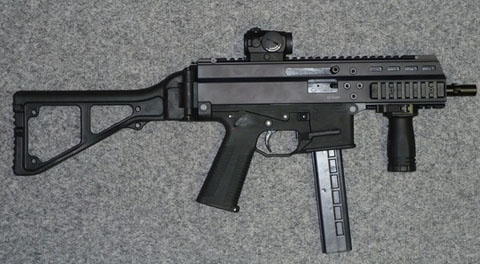
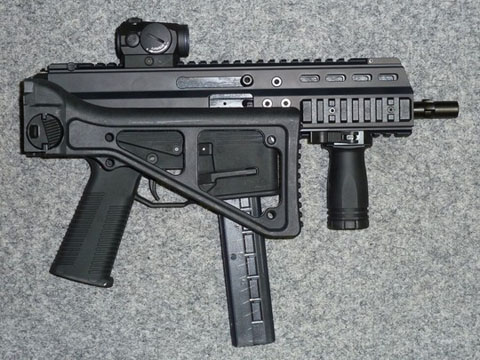
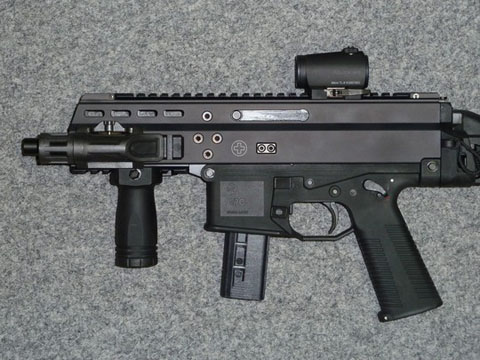



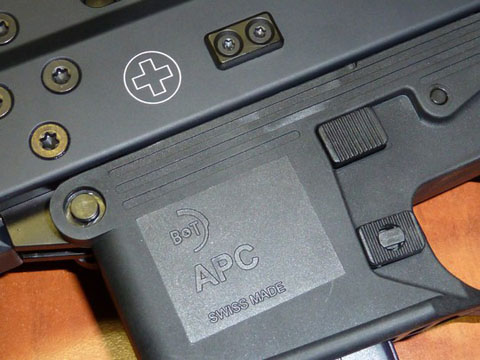


By Steve, thefirearmblog
BLOG ARCHIVES

2012年04月18日
Sako TRG-42 .338 Lapua Mag
私たちのブログを訪問していただきありがとうございます。あなたがお持ちの場合DIYの要求は私達に電子メールを送信してください。
A lightweight and adaptable sniping system that goes beyond 1,750 meters!

Sako’s TRG-42 .338 Lapua Mag gives long-range snipers a highly precise, suppressed bolt-action rifle ready for action. It is topped off with a Schmidt & Bender PM II 5-25×56mm scope.
The sniping caliber of choice for many special operations units today has become .338 Lapua Mag. Incredibly accurate at ¼-MOA or better, sniping rifles in this caliber weigh only a pound or two more than .308 sniping rifles and allow special ops snipers to reach out to more than twice the distance and hit with substantially more power. Since special operators are normally tasked with acting as force multipliers, the advantages of the .338 round are highly valued. The availability of folding stocks for the two or three most popular special ops .338 Lapua rifles allows them be even more portable when deployed from helicopters, small boats, or by foot.
The most widely used .338 Lapua loads can push a 250-grain bullet 2,950 fps (feet per second) and produce 4,800 fpe (foot-pounds of energy). At 1,000 meters, a .338 Lapua bullet could still penetrate five layers of military body armor. Maximum effective range of the round is usually given at 1,750 meters, but it has been used at even greater ranges. Despite being a high-performance sniping cartridge, the .338 Lapua round does not actually cause as much barrel wear as some other cartridges — an important consideration in a sniping rifle, since good snipers practice a lot.

The buttstock is fully adjustable for cheek height, length of pull and pad position. It also contains an integral monopod to complete the support of the rifle for precision shot placement. A simple but rock-solid hinge system locks the folding stock into the extended or collapsed position.
I have now done a reasonable amount of shooting with the four .338 sniping rifles most widely used by special operators and like some aspects of each of them, But Sako’s TRG-42 is truly an outstanding rifle. Many anti-terrorist units around the world use it; among the countries that assign the TRG-42 to their special ops units as their .338 Lapua sniper rifle are Albania, Denmark, Finland, Estonia, Greece, Italy, Russia, Spain, Switzerland, and Turkey.
The .338 Lapua TRG-42 model tested is the OD (Olive Drab/ green), folding stock variant, which is the model used by most units. Black and OD/green fixed stocks are also available. The 27.13-inch tapered, target-grade, chrome moly barrel is cold hammer forged for toughness and accuracy. It has a black phosphate finish. The barrel is threaded for a muzzle brake. Note that the threaded barrel will also take a suppressor. Twist in .338 Lapua is 1-in-12 inches, a rate considered optimum for the 250-grain load used by most military snipers. Overall length with the stock deployed is 49.75 inches and with the stock folded 40.25 inches. Lengths are with muzzle brake installed.

The aggressive muzzle brake helped to tame the felt recoil of the .338 Lapua Mag.
It weighs about 17.5 pounds with the scope and bipod attached, which keeps the TRG-42 portable enough that an operator can transport it into a shooting position quite readily. Note that in comparisons based on published weights for the fixed stock TRG-42, the folding stock version is actually heavier. Yet the TRG-42 is still a couple of pounds lighter than competitive .338 Lapua sniper rifles even with the folding stock.
By Leroy Thompson
BLOG ARCHIVES

2012年04月18日
Optimum Tac Scopes
私たちのブログを訪問していただきありがとうございます。あなたがお持ちの場合DIYの要求は私達に電子メールを送信してください。
Without proper glass, even the most high-end precision rifle is a worthless club in combat!
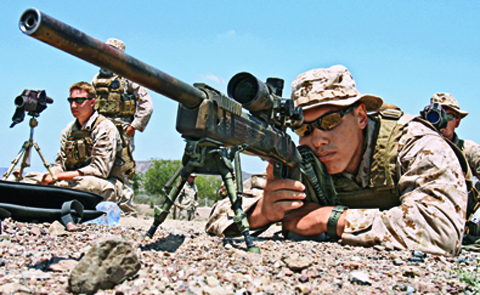
U.S. Marine Corps Sgt. Tim R. Lee, with Scout Sniper Platoon, Headquarters and Support Company, Battalion Landing Team, 1st Battalion, 9th Marine Regiment, 24th Marine Expeditionary Unit (MEU), fine tunes the sights of his M-40 sniper rifle before the first stage of a three-day platoon competition in Djibouti March 25, 2010. The contest challenges scout snipers in communication, marksmanship and teamwork during competitive relays. The 24th MEU is on a seven-month deployment aboard Nassau Amphibious Ready Group vessels as the theater reserve force for Central Command. (U.S. Marine Corps photo by Sgt. Alex C. Sauceda/Released)
With the popularity of tactical precision rifle shooting on the increase, it naturally follows that new participants want to get the most from their choices. While rifle selection is without a doubt a top priority, choosing a tactical scope is nearly as important. In fact, it’s so important that it literally controls how effective both the rifle and its operator will be.
When the newcomer first peruses the mind-boggling array of tactical scopes currently available, he more often than not finds himself, “on the horns of a dilemma.” Small wonder — there are so many different types and designs being offered these days. So many, in fact, that even the more experienced tactical precision rifle shooter can find himself confused as to which one is best for his needs.
After spending a sizeable chunk of money on a factory or custom-made rifle, the shooter also crashes into the fact that any tactical scope worth having isn’t going to be cheap. Thus, he needs to resign himself to spending a bit more to get the best scope he possibly can.
By Chuck Taylor, Images by DoD Photo
BLOG ARCHIVES


